https://www.youtube.com/watch?v=LpDLynrXln8
How to Unclog Any Drain _ Ask This Old House

Look at this , Richard literally everything , but the kitchen sink actually just about .
So I thought we would just take a minute and go over all the ways that you can actually get a stoppage and then clear them .
And the most common quite often is the toilet stoppage .
It usually happens when people are over or kids .
It's a big deal .
So I thought it would make sense to start with sort of seeing what happens inside of a toilet bowl .
This is the water line right here , right ?
And you see water right here .
But people don't realize , I don't think that there's a passage way that comes up here , goes up this little short leg and then down through this really convoluted path , you notice it gets slightly smaller as you go down here .
And so if this had solid waste and paper jammed in right here and you try to take a plunger and just push it , you actually could work against yourself and you could compress it .
So actually the tip I want to give on a plunger is get it seated right here .
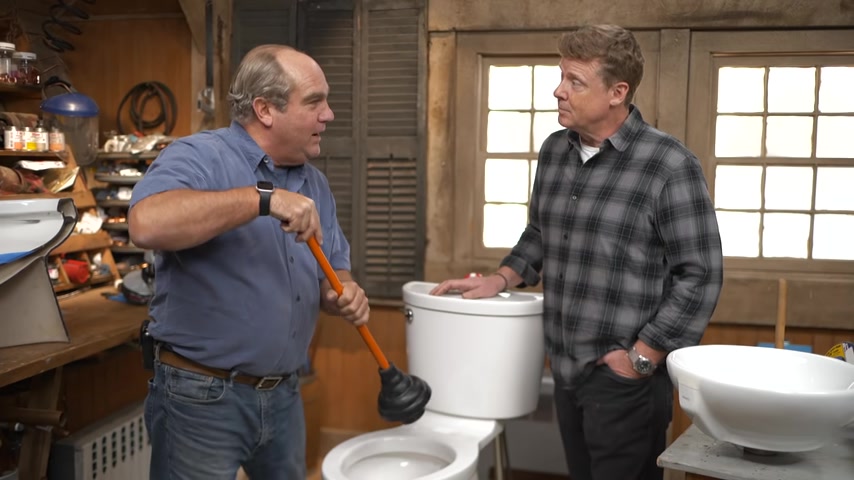
Push down a little bit , a little bit , a little bit just to get a seal and then pull it back the other way .
So now you're gonna actually draw that stoppage up a little bit just to break it up and then it should get clear .
Not always though .
No , they make an ex a tool expressly for clearing these things .
So if you took a regular wire and just tried to clear this , you would scrape this China .
So this is called a closet A .
So if you see right here , there's a protective coating right here on this arm .
Now , what you do is you advance this gently up through , it'll just pass through here clear in any stoppage .
So the action would be like this and somewhere inside the guts that wire , push it , push it , push it , ok .
It has a hook on it .
So it's sort of like fish and caf I kind of Richard , but I got one , I know you're a plumber .
I get it .
All right .
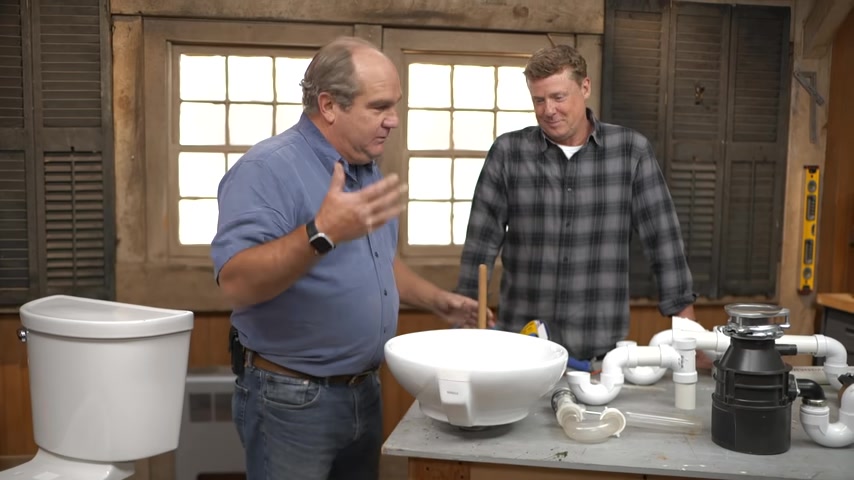
So now on a lavatory , we can start the attack with a , on the lavatory with a plunger .
But there's one important call out and that is if you look right here on any lavatory that's legal , it's supposed to have a thing called an overflow right here .
It might be at the front , it might be at the back like this .
Uh But what happens is if we now put a plunger on it and there's a stoppage below it , what's gonna happen is every bit of the force you do here could come right out at you .
So it's really important to block this off so that all that hydraulic force going down and not out at you .
And , and typically when we're getting these clogs , they're in the trap quite often .
Here's the typical sort of cross section underneath the sink .
You've got a pop up assembly in a lavatory .
You got this linkage right here .
This is a place where hair will often clogs .
Oftentimes you can take apart the trap and dump it out and see what's going on .
But many times you've got to come down , you pull this out and you gotta come down with a wire .

So similar to your closet a over there , this is gonna just push it down , you just advance it gently , there's a , there's an advance right here .
So you do a little , then you lock it , you just keep on advancing , driving it down through , but you're not done yet .
Just imagine this trap is right here .
So you get down through the pop up assembly down through the trap and you come to here now in a lavatory , it might be just a short line right here and the wire has a choice to go .
You hope down where the stoppage might be because that's where the liquid is going .
But if it's p plumbed properly , there's a , a line that goes up and ultimately out through the roof .
So that's the vent .
You hope that by gravity , the tip of the wire would go this way .
You just keep doing it and doing it or you bend the wire and you , and so , and sometimes you have to cut it and put a clean out in , ok , similar on a disposal .
And so now with this , you have to take this apart and find a way to get the wire down in here .
Got you .
I do want to call out one thing on a lavatory though .

You think it was hard to get the wire to go this way ?
I showed you this because this is how well you know this bathrooms that have two lavatories and this might be , this might be the way that the plumber roughed it in .
Ok .
So you , you cut down through here with the wire .
Where does it go over here over here ?
And it comes , it comes waving to you out the other sink when it really wants to go .
Come here .
Ok .
So if the original plumber cared at all about us , they would have done this so that the wire , do you see this ?
The wire would have no choice but to go here .
And this is actually not legal in many , many jurisdiction .
So it's , it's literally just a highway for the wire .
Now , it actually will put it going in the right direction .
That's right .
So it won't go up the vent .
Ok .
Alright .
So that's lavatories .
And this is also the drain .
Now , in a bathtub , bathtub , you can use a plunger , but the same rules apply .
That was over here at the lavatory because this is an overflow right here .

So if you did this , you'd have to pull this plate off , block this off .
Let me hold it up here .
So , so right now this is the bottom of the tub right here .
This is the , and this is the part you'd see in the tub right here .
Valves up , here's the , here's that mechanism to do it .
You take that off , you do this .
And so if you do this , you gotta block this off and then the force of that plunger would push this way , right ?
Ok .
But what people make the mistake is they take the wire and they go in here , it's no different .
So it's got , it can come back waving at you again .
I , I don't understand how you made it through a career plumbing .
It must have driven you absolutely crazy .
So you really wanna do this , you wanna come down this way .
So don't go through the show .
You don't go through that .
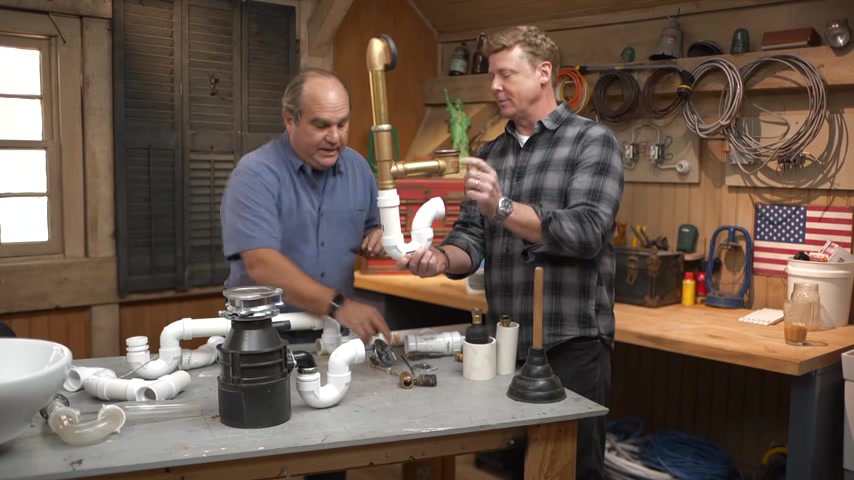
You come down through here and then just gently advance , gently , advance , tighten this up and just come down and you come right down through the trap and then you'll clear it because again , I think it's important for people to realize that the clog is not typically here , the trap , it's gonna be in the trap oftentimes , which is always down here now , there can be hair in the , in the mechanism .
So , I mean , that could be here .
And so is that from the personal collection I just brought it from home , is that the personal , I don't have any money to lose ?
All right .
So that's an important tip to come down this way .
Ok .
And this is all the stuff that's gonna be up at the fixture where the trap is .
But sooner or later it goes down to the basement or down below into a larger pipe .
And so at this point , you may have to step up from a little wire like this to get a more a bigger power wire .
And so at every change of direction , every time water comes down here and turns this way by code , it's supposed to have a clean out .
Ok .
So this clean out now becomes a place that a wire could go in here .
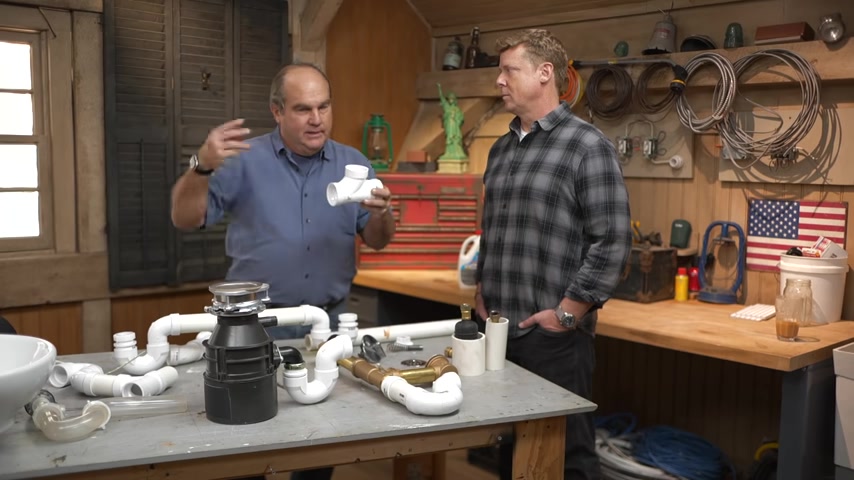
And I wanna make this point , you know , if you run a wire in there , you really want to find a way to run that wire and run it in there and also run water down the drain .
Because if you looked inside of a , a long kitchen sink drain , and if you looked , you'd probably see the bottom quarter or bottom third just filled with , with solid waste .
And so if you just ran a wire in there a little bit , it wouldn't necessarily flush it or clean it .
So you really have to find a way to run the wire , bang it around inside , disturb it , loosen it and let the water run throughout the whole thing .
Ok .
So that's , that's really important .
And then I wanna call out something that's pretty interesting .
Isn't this a for a water hammer ?
Well , no , no , it looks like you've been paying attention .
What is this thing ?
So this is gonna use the power of hydraulic force .
So with this coming through our clean up , right ?
You take this off , you , you connect this to a hose and you would put it down inside here as far as you wanted it to go .
Say you want to get down to this point .
So we're driving it downstream .
This is specifically made for clearing cloud .
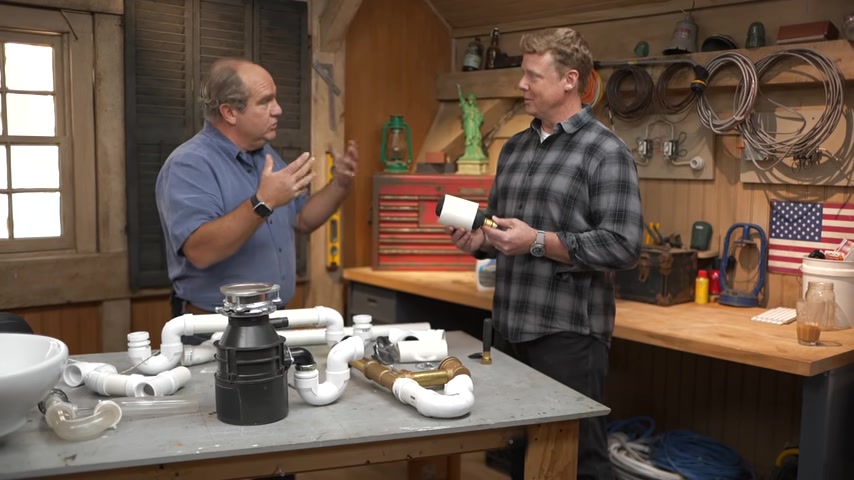
So now what it's gonna do is it's gonna fill up , right ?
The water's gonna pressurize this and make it filled up .
You can't fit that one .
It's gonna fill up that void , but look what's at the end little hole .
So now that would pressurize and seal off right here .
No water is coming out .
No , it would , it wouldn't come this way .
And now this small hole would now pressurize and force water down to where the clog is .
Ok .
So this actually has some advantage to get into places .
I will caution you if you've got ancient galvanized piping , you're now putting pressure where there hasn't been any pressure for a long time .
So you could expose a leak .
But it's , it would be a way to sort of easily push that clog down the downstream .
It's unbelievable .
So there are a lot of places where it can go wrong , but there are a lot of solutions that , that , that's right .
So what most people want to do is do this , they want to put some chemical down there .
I just wanna put a caution out to you .
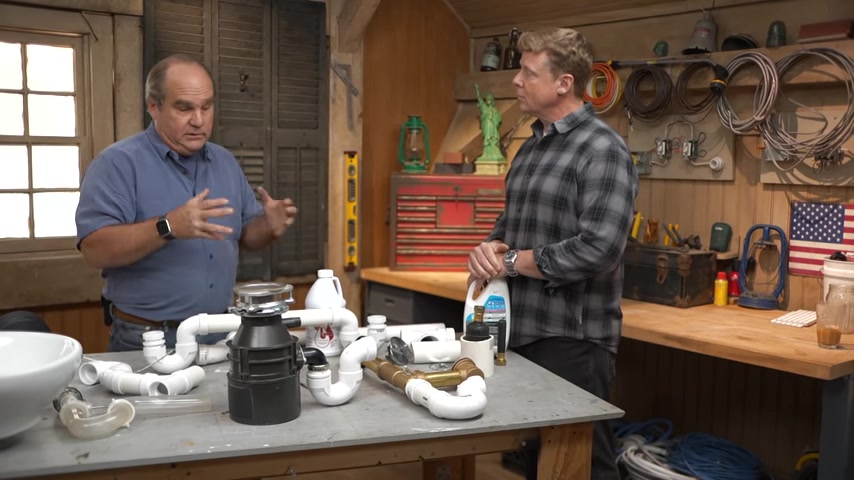
If you have a real stoppage , this chemical is not going to make a difference .
It's only going to add to danger for the people that do have to come along afterwards right there .
So what do you think never use ?
It's if you have maybe on an ongoing basis to sort of get organic matter that might be there , but nothing beats the mechanical solution to clean the wire , flush it and keep that pipe clean and , and you know , and this also if left in there , I've seen it where it sits in that long horizontal old pipe and it eats away at the bottom of that pipe .
And most importantly , you can't go fishing with this .
All right .
That did .
Thank you very much .
Thank you .
Thanks for watching .
This old house has got a video for just about every home improvement project .
So be sure to check out the others .
And if you'd like me to see , click on the subscribe button to make sure that you get our newest videos right in your feet .
Are you looking for a way to reach a wider audience and get more views on your videos?
Our innovative video to text transcribing service can help you do just that.
We provide accurate transcriptions of your videos along with visual content that will help you attract new viewers and keep them engaged. Plus, our data analytics and ad campaign tools can help you monetize your content and maximize your revenue.
Let's partner up and take your video content to the next level!
Contact us today to learn more.